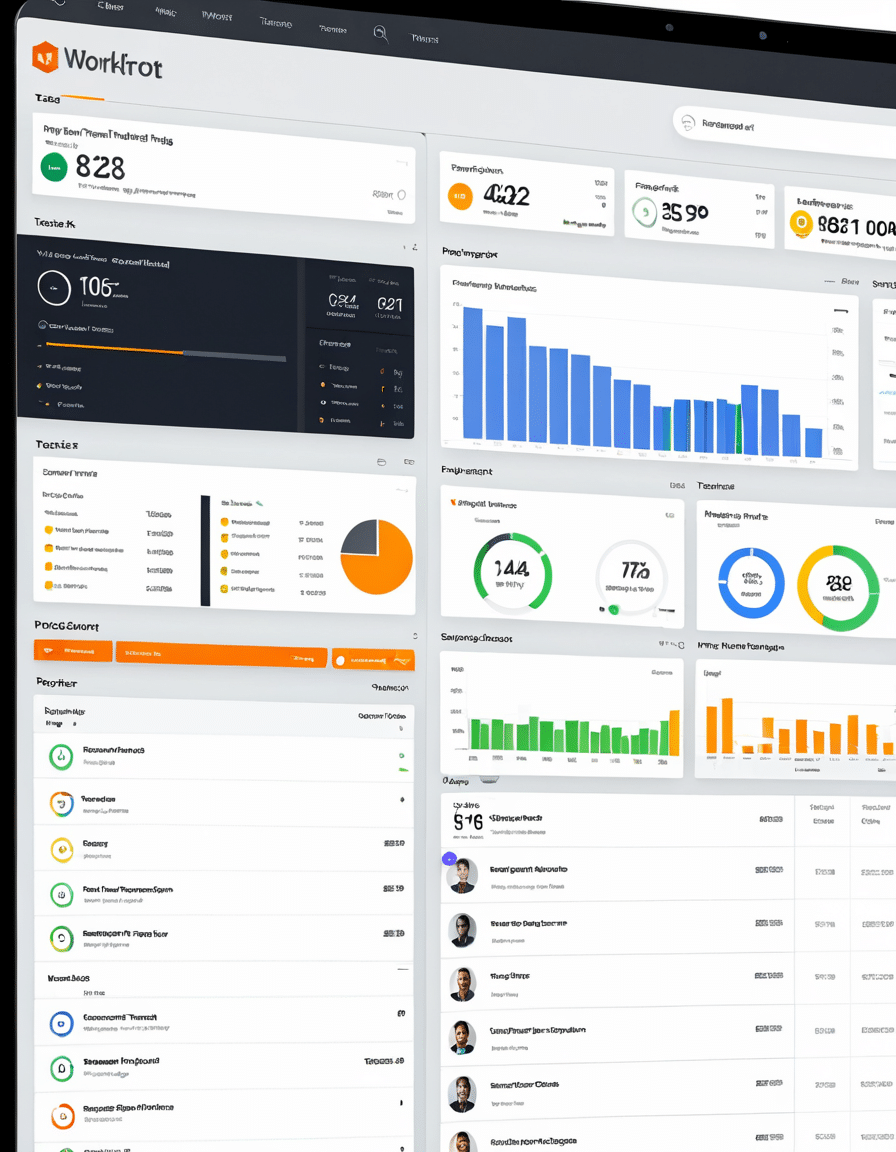In today’s fast-paced work environment, organizations constantly seek tools that can optimize performance without the complexity. Enter Workfront—a dynamic platform designed to transform modern project management. Leveraging its features, teams can streamline workflows, boost collaboration, and enhance overall project execution. As companies adapt to ever-changing demands, Workfront steps in to offer solutions that not only simplify operations but elevate project outcomes. Let’s delve into seven key attributes that make Workfront a standout choice in 2026.
7 Reasons Why Workfront is Transforming Project Management

1. Comprehensive Integration Capabilities
One of Workfront’s shining features is its ability to play nice with other tools like Jira, Slack, and Salesforce. This powerful integration consolidates various functionalities into one central hub, cutting down the hassle of juggling multiple applications. Consequently, teams can manage projects and workflows more easily, improving productivity and reducing the chances of miscommunication.
For instance, organizations can track tasks directly within Workfront while pulling in data from different platforms, allowing teams to stay synchronized without losing a beat.
2. AI-Driven Insights and Analytics
As we push further into the digital age, the rise of artificial intelligence (AI) in project management is becoming paramount. Workfront utilizes AI to glean real-time insights into project performance. With features like predictive analytics, Workfront helps forecast project risks and suggests actionable solutions.
Organizations such as Adobe have harnessed these capabilities, slashing project delays and boosting efficiency across teams. By analyzing trends and patterns, Workfront empowers managers to stay ahead of potential pitfalls.
3. Enhanced Visibility and Reporting
Another ace up Workfront’s sleeve is its robust reporting capabilities. Project managers can generate custom reports, offering insights into various metrics such as team performance, budget usage, and timelines. Take Coca-Cola, which uses Workfront to maintain visibility across its global marketing teams, ensuring campaigns align with strategic objectives.
This level of clarity enables decision-makers to make informed choices grounded in data, not speculation. By relying on actionable insights, companies can optimize operations and successfully navigate project hurdles.
4. User-Centric Design and Experience
User experience can make or break a tool’s adoption in any organization. Luckily, Workfront prides itself on its user-friendly design that reduces the learning curve for newcomers. Consequently, brands like Dell have benefited from quicker onboarding and smoother transitions when introducing new users to the platform.
By prioritizing ease of use, teams experience less resistance to adopting new tools, fostering a productive work atmosphere. This, in turn, enhances overall morale and aids in project success.
5. Advanced Resource Management
Resource management remains a core pillar in effective project management, and Workfront excels here. It provides advanced tools that optimize resource allocation based on skills, availability, and project needs.
Companies like IBM have effectively utilized these features, ensuring talent aligns with the right tasks. This approach not only reduces burnout but also boosts employee satisfaction, as team members find themselves working in areas best suited to their strengths.
6. Fake Hacking Prevention Techniques
In today’s digital landscape, security is non-negotiable. Workfront understands this and implements state-of-the-art security measures that protect against threats like fake hacking. For example, Microsoft relies on these features to secure sensitive project data, building trust among stakeholders and complying with industry standards.
With constant monitoring for unusual activity, organizations can focus on project tasks without losing sleep over data breaches. Knowing that security is a top priority enables teams to collaborate more freely.
7. Collaborative Features that Foster Teamwork
Collaboration is at the core of effective project management, and Workfront elevates this aspect with features that encourage teamwork. Tools like shared calendars, file sharing, and integrated communication channels keep everyone in sync, promoting a unified approach to projects.
Spotify exemplifies this; they recognize the value of a collaborative environment to inspire creativity and innovation. Embracing Workfront’s collaborative features, teams streamline their creative processes and transform ideas into action.

Transforming Project Management Ecosystems with Workfront
As we look ahead to the evolving demands of modern project management, Workfront stands out as more than just a tool. It’s a transformative force that reshapes collaboration and efficiency. By merging user-friendly designs, powerful analytics, and robust collaboration features, Workfront caters to the ever-shifting needs of project managers and their teams.
In a landscape where adaptability is key, Workfront’s capabilities ensure that organizations meet their deadlines while exceeding stakeholders’ expectations. With ongoing innovations and a commitment to improvement, Workfront is poised to redefine project management for the future. As companies tackle today’s challenges and seize tomorrow’s opportunities, they do so with confidence, knowing they have the right tools to thrive in a competitive marketplace.
For those in the project management sphere, embracing Workfront could very well be the game-changer needed to elevate team performance, mitigate risks like fake hacking, and foster a culture of collaboration that drives success.
Workfront: Revolutionizing Modern Project Management
The Power of Collaboration
Did you know that agility is no longer just a buzzword in project management? With platforms like workfront, teams can seamlessly collaborate across time zones and work styles. For instance, the rise of remote work has highlighted the need for efficient task management tools. Speaking of teamwork, have you heard of Matthew Berry? He’s not only a fantasy sports guru but also a figure who emphasizes strategic collaboration in various fields—a principle mirrored by workfront functionalities. It’s all about bringing the best minds together!
Trends and Innovations
As businesses face new challenges, companies are increasingly looking for solutions that evolve with them. That’s where workfront shines! For example, its integration capabilities make it easy to link with other popular tools, much like how Travis Matthews connects fashion with athletic performance through his clothing line. Speaking of trends, have you caught wind of the latest in sustainable fashion? Brands like Vuori Clothing are leading the charge, showcasing how innovation can meet consumer needs—much like workfront does in project management.
Fun Facts to Ponder
Here’s a fun nugget for you: creativity isn’t just for artists! Project managers can boost their creativity through effective tools like workfront, which helps foster an environment of innovation. And let’s not forget about those unexpected integrations; who would’ve thought that smiling farm animals could impact productivity? Much like in Silent Hill, where every detail counts, in project management, it’s the little things that often make significant differences. Connect your team’s strengths with tools that greatly assist in the execution of big ideas, just as folks connect over intriguing subjects like who Jonathan Majors’ girlfriend is or the latest buzz surrounding Xevbellringers rise to prominence!
By leveraging modern solutions like workfront, you’re not just managing tasks; you’re paving the way for more efficient and inspired collaboration. After all, in the highly competitive landscape of project management, being equipped is half the victory!

What is Workfront used for?
Workfront is mainly used for project management, helping teams collaborate more effectively by tracking tasks, resources, and deadlines all in one place.
Is Workfront similar to Jira?
While Workfront and Jira both serve project management needs, they’re geared towards different audiences; Workfront is often used for marketing and creative teams, while Jira is more tailored for software development.
What did Workfront used to be called?
Workfront used to be called “AtTask” before it rebranded to better reflect its capabilities and broaden its appeal in the project management space.
Who uses Workfront?
You’ll find Workfront being used by marketing teams, creative agencies, and basically any organization looking to streamline their project workflows and improve collaboration.
Is Workfront easy to learn?
It’s generally considered easy to learn, especially with the user-friendly interface, but like any tool, there’s a bit of a learning curve as users get familiar with its features.
What type of tool is Workfront?
Workfront is primarily a project management tool, designed to help organizations plan, execute, and deliver projects more efficiently.
What replaced Jira?
Jira has been replaced by various tools depending on specific needs, but options like Workfront, Asana, or Microsoft Project are often seen as alternatives.
Is Workfront an ERP system?
Nope, Workfront isn’t an ERP system; it focuses more on project management rather than the financial and operational aspects typically found in ERP software.
Why did Adobe buy Workfront?
Adobe bought Workfront to enhance its creative cloud offerings and provide a more integrated platform that supports collaborative work for marketing and content teams.
Which project management tool is best?
The best project management tool really depends on your team’s needs and preferences, but popular choices include Workfront, Asana, Trello, and Monday.com.
Is Workfront a CRM?
Workfront is not a CRM; it focuses on managing projects and workflows rather than maintaining customer relationships and sales data.
What are issues in Workfront?
Issues in Workfront refer to tasks or problems that need to be tracked and managed during the project lifecycle, helping teams to resolve them quickly.
What are the benefits of Adobe Workfront?
Adobe Workfront offers benefits like enhanced collaboration, better visibility into project statuses, and improved resource management, making it easier to deliver on time.
Is Workfront like asana?
Workfront and Asana both aim to improve project management, but Workfront has a stronger focus on larger teams with more complex workflows.
What are the goals of Workfront?
The goals of Workfront include improving project visibility, increasing team collaboration, and ensuring that work aligns with business objectives for greater efficiency.
What are the goals of Adobe Workfront?
Adobe Workfront aims to streamline processes, enhance team collaboration, and ultimately drive better project outcomes to help organizations be more productive.
What is Microsoft Workfront?
Microsoft Workfront is a bit of a mix-up; it’s Adobe Workfront, which is integrated with Microsoft products to improve workflows and project management.
What is the role of the Workfront administrator?
The Workfront administrator plays a key role in managing user access, configuring project settings, and providing support to ensure teams use the tool effectively.
What is Adobe Workfront similar to?
Adobe Workfront is similar to tools like Asana and Trello in that they all focus on task and project management, but Workfront offers more robust features for larger teams.





















